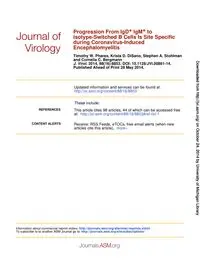
2014 Progression From IgD+ IgM+ to Isotype-Switched B Cells Is Site Specific during Coronavirus-Induced Encephalomyeliti PDF
Preview 2014 Progression From IgD+ IgM+ to Isotype-Switched B Cells Is Site Specific during Coronavirus-Induced Encephalomyeliti
Published Ahead of Print 28 May 2014. 2014, 88(16):8853. DOI: 10.1128/JVI.00861-14. J. Virol. and Cornelia C. Bergmann Timothy W. Phares, Krista D. DiSano, Stephen A. Stohlman Encephalomyelitis during Coronavirus-Induced Isotype-Switched B Cells Is Site Specific to + IgM + Progression From IgD http://jvi.asm.org/content/88/16/8853 Updated information and services can be found at: These include: REFERENCES http://jvi.asm.org/content/88/16/8853#ref-list-1 at: This article cites 98 articles, 44 of which can be accessed free CONTENT ALERTS more» articles cite this article), Receive: RSS Feeds, eTOCs, free email alerts (when new http://journals.asm.org/site/misc/reprints.xhtml Information about commercial reprint orders: http://journals.asm.org/site/subscriptions/ To subscribe to to another ASM Journal go to: on October 24, 2014 by University of Michigan Library http://jvi.asm.org/ Downloaded from on October 24, 2014 by University of Michigan Library http://jvi.asm.org/ Downloaded from Progression From IgD� IgM� to Isotype-Switched B Cells Is Site Specific during Coronavirus-Induced Encephalomyelitis Timothy W. Phares,a Krista D. DiSano,a,b Stephen A. Stohlman,a Cornelia C. Bergmanna Department of Neurosciences, Lerner Research Institute, Cleveland Clinic Foundation, Cleveland, Ohio, USAa; School of Biomedical Sciences, Kent State University, Kent, Ohio, USAb ABSTRACT Various infections in the central nervous system (CNS) trigger B cell accumulation; however, the relative dynamics between viral replication and alterations in distinct B cell subsets are largely unknown. Using a glia-tropic coronavirus infection, which is ini- tiated in the brain but rapidly spreads to and predominantly persists in the spinal cord, this study characterizes longitudinal changes in B cell subsets at both infected anatomical sites. The phase of T cell-dependent, antibody-independent control of infec- tious virus was associated with a similar recruitment of naive/early-activated IgD� IgM� B cells into both the brain and spinal cord. This population was progressively replaced by CD138� IgD� IgM� B cells, isotype-switched CD138� IgD� IgM� memory B cells (Bmem), and CD138� antibody-secreting cells (ASC). A more rapid transition to Bmem and ASC in spinal cord than in brain was associated with higher levels of persisting viral RNA and transcripts encoding factors promoting B cell migration, dif- ferentiation, and survival. The results demonstrate that naive/early-activated B cells are recruited early during coronavirus CNS infection but are subsequently replaced by more differentiated B cells. Furthermore, viral persistence, even at low levels, is a driving force for accumulation of isotype-switched Bmem and ASC. IMPORTANCE Acute and chronic human CNS infections are associated with an accumulation of heterogeneous B cell subsets; however, their influence on viral load and disease is unclear. Using a glia-tropic coronavirus model, we demonstrate that the accumulation of B cells ranging from early-activated to isotype-switched differentiation stages is both temporally and spatially orchestrated. Acutely infected brains and spinal cords indiscriminately recruit a homogeneous population of early-activated B cells, which is progressively replaced by diverse, more differentiated subsets. The latter process is accelerated by elevated proinflammatory re- sponses associated with viral persistence. The results imply that early-recruited B cells do not have antiviral function but may contribute to the inflammatory environment or act as antigen-presenting cells. Moreover, CNS viral persistence is a driving force promoting differentiated B cells with protective potential. C entral nervous system (CNS) inflammation during microbial infections, autoimmunity, or spinal cord injury is associated with recruitment of various B cell subsets, including antibody- secreting cells (ASC) (1–5). In cases of acute encephalitis, B cell and antibody (Ab) accumulation is transient; however, humoral responses persist during chronic CNS diseases such as subacute sclerosing panencephalitis and multiple sclerosis (MS) (6–8). However, the mechanisms driving the accumulation of various B cells as well as their phenotype, role, and precursor relationships to ASC are poorly defined. In patients with subacute sclerosing panencephalitis, the majority of oligoclonal Ab bands are measles virus specific, suggesting that persisting viral antigen drives local humoral responses (6, 9), yet their role is difficult to assess. A large proportion of CNS-localized ASC in Sindbis virus and neu- rotropic coronavirus infection models is also virus specific and correlated with protection (2, 4, 10). One mechanism thought to promote local CNS B cell differen- tiation and Ab production involves the formation of ectopic fol- licle-like structures, as described previously for neuroborreliosis and MS (11–13). Ectopic follicle formation in the CNS during microbial or autoimmune inflammation is supported by the con- stitutive and induced expression of several factors regulating B cell responses in lymphoid organs. Among these factors are the chemokines CXCL13, CCL19, and CCL21, which guide B cell mi- gration within lymph nodes, as well as CXCL9, CXCL10, and CXCL12, which are implicated in ASC trafficking (3, 14–16). Moreover, factors involved in both B cell differentiation, such as interleukin-6 (IL-6), IL-10, and IL-21, as well as B cell survival, namely, B cell-activating factor of the tumor necrosis factor (TNF) family (BAFF) and a proliferation-inducing ligand (APRIL), are also upregulated during virus- or autoantigen-induced CNS in- flammation (3, 15, 17–19). Although CXCL13 is implicated in the formation of ectopic follicle-like structures in the CNS (11–13, 16), there is no evidence for ectopic lymphoid follicles during Sindbis virus infection, despite the expression of CXCL13 and CCL19 and the presence of various B cell subsets within the CNS (2, 15). Increasing proportions of isotype-switched memory B cells (Bmem) and ASC during Sindbis virus CNS persistence thus suggested that B cell subset alterations toward a more differenti- ated phenotype may reflect their egress into circulation from pe- ripheral maturation sites and survival in the CNS (2). Early B cell Received 25 March 2014 Accepted 21 May 2014 Published ahead of print 28 May 2014 Editor: S. Perlman Address correspondence to Cornelia C. Bergmann,
